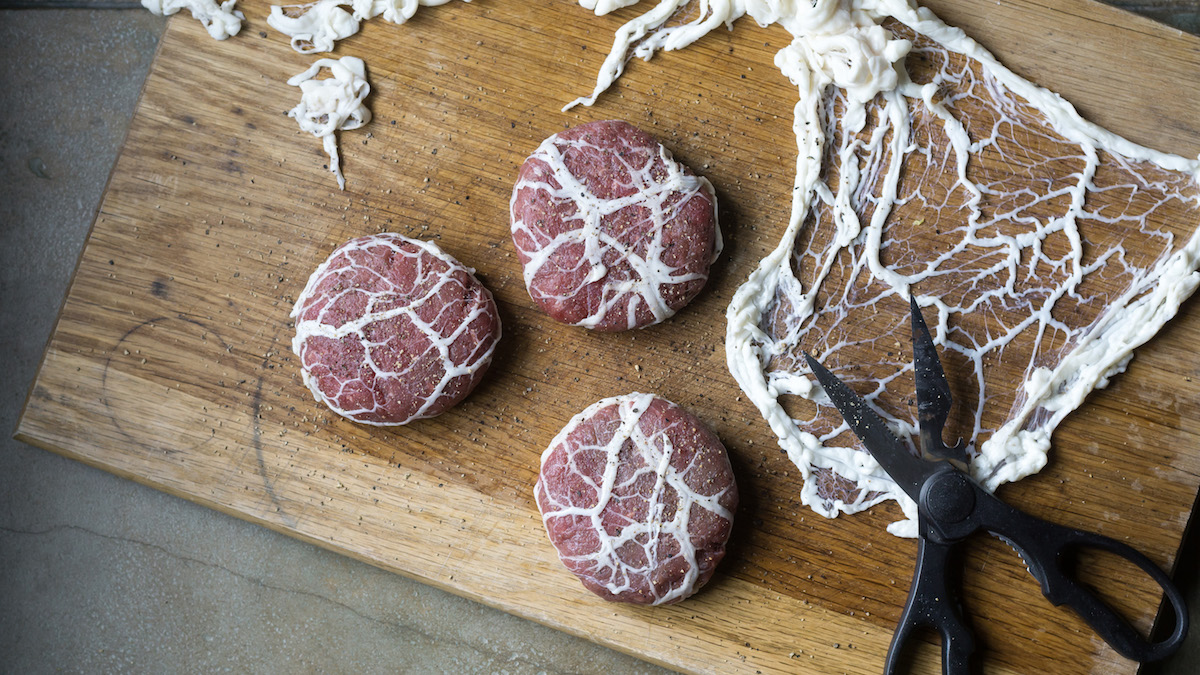
When field dressing a deer, you’ll find a thin, lacy net covering the stomach. Don’t mistake this for something to be left in the gut pile. Although it doesn’t resemble a prime cut, this web of valuable fat is great for imparting flavor, moisture, and shape into meals.
What is Caul Fat?
Caul fat, sometimes referred to as lace fat, is a delicate, thin membrane of connective tissue with fat deposits embedded in it. This sheath covers the stomach in the abdominal cavity of deer, pigs, cows, and sheep. While it looks a bit intimidating, it’s easy to remove as long as you’re cautious.
To remove caul fat intact, you need to make small cuts where it attaches to the spleen. Always take the utmost care to not puncture the guts because you don’t want intestinal fluids tainting the meat or fat. I try to make as few cuts as possible. Once the caul fat is free from the organs, you can gently pull the rest of it off the stomach. If you take your time with this process, you’ll be able to recover most of this delicious organ.
The goal is to get it out in one piece, but don’t be discouraged if it rips. The beauty of caul fat is that it’s self-adhesive, which makes it easy to put back together when wrapping meat.
How to Clean Caul Fat
Caul fat can tear easy, so don’t throw it in an icy cooler with the rest of the meat. It’s best to have a few plastic bags handy in the field for storage when you’re gutting an animal. Bagging it separately not only protects the structure, but also helps prevent debris from getting in the web.
Always wash caul fat before cooking with it. Washing not only cleans the web, but also helps rid it of any weird intestinal smells. You can either do this in a colander and continuously run water through it, or soak it in a bowl of saltwater to purge blood and dirt.
You can cook with it right away or store it in the freezer. I like to cut the web in half and freeze it in two portions. Over time, fat oxidizes in the freezer, making it go rancid faster than meat. Since caul fat is 90% fat, it’s best to use within a year or two, although I haven’t tested the limits yet.
How to Cook Caul Fat
Defrost caul fat in the fridge a day in advance of cooking. It is saturated fat, so it will retain the shape it took when frozen and remain hard until heated. To make it more pliable, place the caul fat in a bowl of lukewarm water before cooking.
Deer are ruminant animals; their fat makeup is even more saturated than ducks or pigs. Fat that comes from the gut cavity is hard. While retrieving the caul fat, you might find other chunks of solid fat inside the gut cavity. Suet attaches to the kidneys, which you can render into tallow.
If you were able to pull the caul fat out in one piece, you’ll probably find a few thick chunks around the outer edges where you cut it away from the organs. These take time to render and are better suited to slow cooking with a generous amount of heat. You can also clarify thick pieces of fat into tallow for other applications.
Tallow cools quickly into a wax-like texture that can coat the roof of your mouth. It isn’t a popular fat to use, although McDonald’s used tallow from beef to fry their French fries until the 1990s.
The main inner web of caul fat is thin and more delicate. This is the section you’ll want to use because it renders quickly and bastes the meat with moisture. Caul fat makes the perfect casing for ground meats or lean muscle.
Caul fat has been used all around the world since Roman times in various cuisines. The most popular dishes are French crépinette and pâté, English faggots, and Italian fegatelli. Some indigenous Native Americans considered the caul fat a delicacy and would celebrate a successful hunt by wrapping it around the heart.
You can apply these same basic principles at home. Barding is a technique for cooking meat wrapped in a layer of fat before roasting over an open fire. I like to think of caul fat as a convenient form of bacon to wrap around lean cuts without an overpowering flavor. You can also get more creative and make a ballotine or use it to wrap your favorite meatball recipe.
Like most hunters, I used to leave caul fat in the gut pile. But after using it a few times and discovering its versatility, I now cherish it like I would a prized roast. Caul fat has forever earned a spot in my freezer, and it should get a place in yours.







